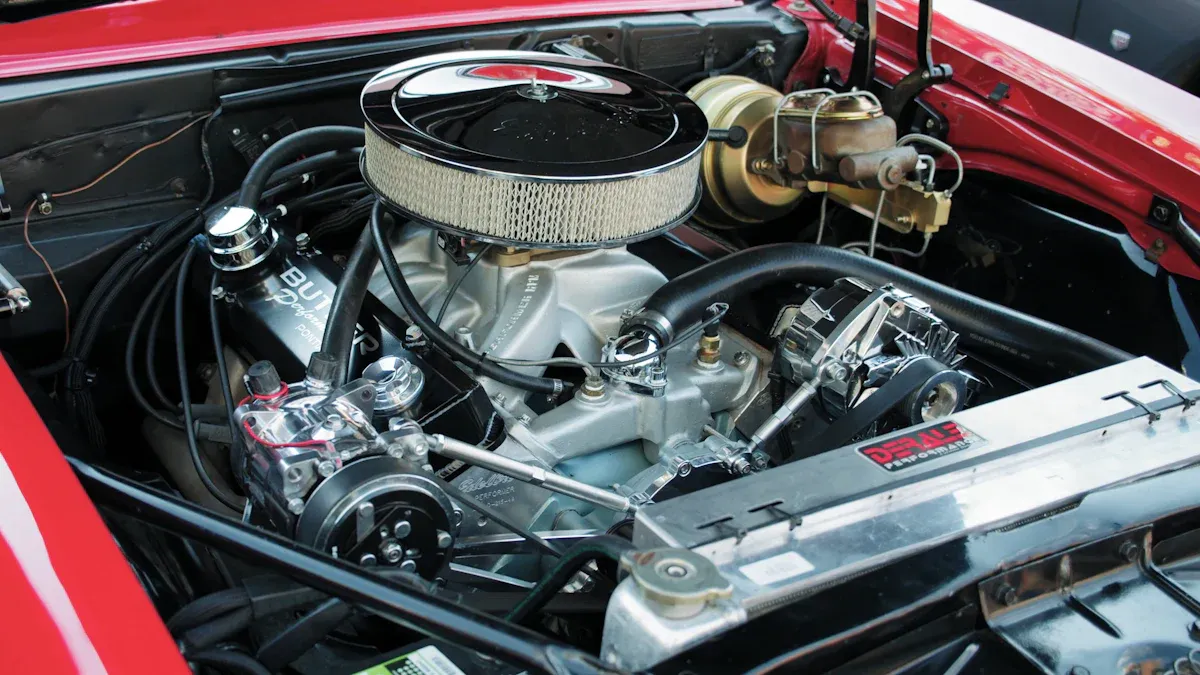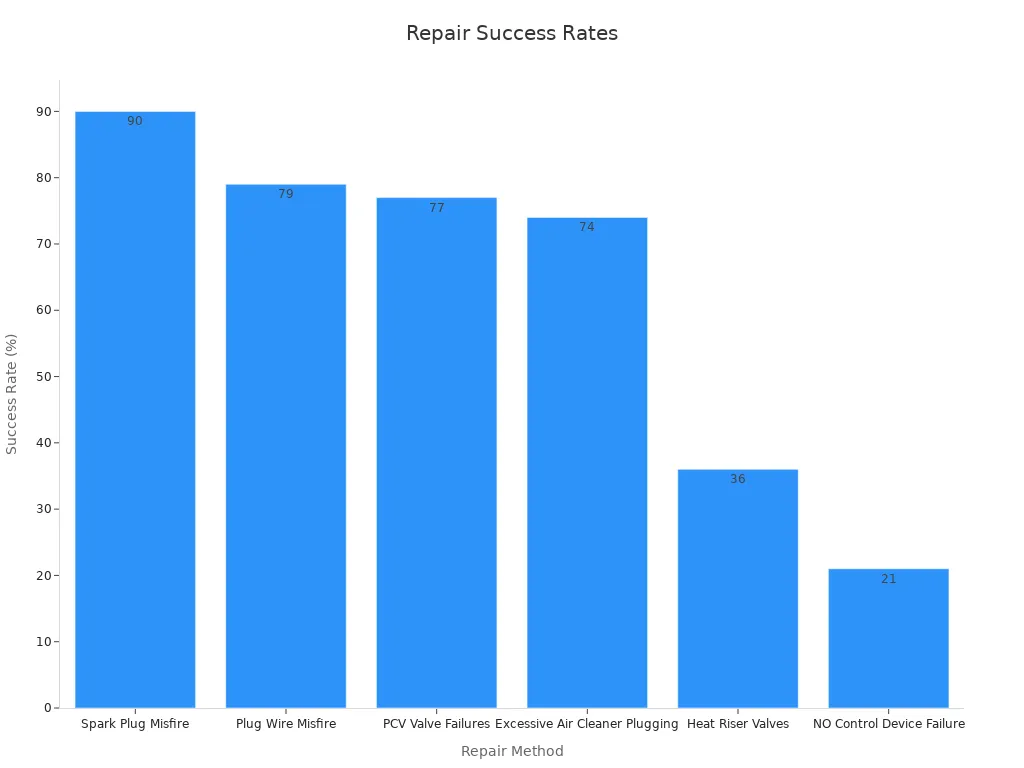How Oxygen Sensors Impact Engine Performance
Oxygen sensors are crucial for maintaining your engine's performance. They monitor oxygen levels in exhaust gases to ensure the fuel-air mixture is optimal. This mixture is vital because even minor changes can lead to issues like misfires. Misfires occur when the engine fails to burn fuel properly. If oxygen sensors malfunction, they can send incorrect information to the engine control unit, which can raise the question: can a oxygen sensor cause a misfire? The answer is yes, as this can result in inefficient fuel burning, increased emissions, and wasted fuel.
Here’s how oxygen sensor voltage indicates the quality of fuel burning:
Low voltage (0.1V–0.3V) signifies insufficient fuel, leading to poor combustion.
Mid-range voltage (0.4V–0.6V) indicates a good balance for smooth operation.
High voltage (0.7V–1.0V) suggests excessive fuel, which can negatively impact efficiency over time.
Oxygen sensors play a key role in maintaining this balance, enhancing engine performance and preventing costly misfire issues.
Key Takeaways
Oxygen sensors check exhaust gases to keep the fuel-air mix right. This is very important for the engine to work well.
A broken oxygen sensor can cause misfires, waste fuel, and make more pollution.
Taking care of your car, like changing spark plugs and cleaning air filters, can stop misfires and improve how the engine runs.
Oxygen sensor readings show how well fuel burns: low readings mean bad burning, while middle readings mean a good mix.
Changing oxygen sensors every 60,000 to 100,000 miles keeps the engine working well and avoids expensive fixes.
An OBD-II scanner can find misfires fast and show problems with oxygen sensors, ignition coils, or fuel injectors.
Bad oxygen sensors can cause rough idling, lower gas mileage, and a check engine light that won’t go away.
Knowing what oxygen sensors do helps you care for your car better. This keeps the engine strong and saves money on repairs.
What Are Engine Misfires?
Engine misfires happen when the air-fuel mix in a cylinder doesn’t burn correctly. This problem affects how the engine works and shows clear signs. Knowing these signs and reasons can help fix the issue early.
Symptoms of Misfires
Rough idling and stalling
If your engine misfires, it may run unevenly when idle. The car might shake or vibrate more than normal. In bad cases, the engine could stop, leaving you stuck.
Loss of power during acceleration
Misfires can make your car lose power when you speed up. The engine may struggle to work smoothly, making driving feel rough or slow.
Increased fuel consumption
Misfires waste fuel because the engine burns it poorly. This makes your car use more gas, lowering efficiency and costing more money.
Causes of Engine Misfires
Problems with the combustion process
Combustion needs fuel, air, and a spark to work. A misfire happens if one of these fails. For example, too much or too little fuel or a weak spark can stop ignition.
Common problems: fuel, air, and spark issues
Many things can cause combustion problems. A blocked fuel injector can stop fuel flow. A dirty air filter can reduce airflow. Bad spark plugs or coils might not create a spark. These problems can all lead to misfires, so finding the exact cause is important.
Tip: Regular care, like changing spark plugs and cleaning air filters, can stop misfires and boost performance.
Can a Oxygen Sensor Cause a Misfire?

How Oxygen Sensors Work
Checking oxygen in exhaust gases
Oxygen sensors are important for how your engine works. They check how much oxygen is in the exhaust gases. This helps decide if the fuel-air mix has too much fuel or air. A good mix burns fuel well and stops engine misfires.
Oxygen sensors are placed in specific spots in the exhaust. Sensors before the catalytic converter check the first combustion. Sensors after the converter make sure emissions are safe. Both types work together to keep the engine running well.
Sending signals to the engine control unit (ECU)
Oxygen sensors send signals to the engine control unit (ECU). The ECU uses these signals to adjust fuel and air levels. If the mix is too lean, the ECU adds more fuel. If it’s too rich, the ECU lowers the fuel amount.
A broken oxygen sensor can mess up these signals. Wrong data can make the ECU adjust poorly, causing misfires. This shows why working oxygen sensors are key for smooth engine performance.
Common Oxygen Sensor Problems
Worn-out or dirty sensors
Oxygen sensors can wear out or get dirty over time. Heat, oil leaks, and carbon buildup can make them less accurate. A worn sensor might give bad readings, leading to misfires.
Cheap or fake sensors can also cause trouble. These might not work as well as original parts. Using them can increase the chance of misfires and other engine problems.
Wrong readings causing bad fuel-air mix
A faulty oxygen sensor can send wrong signals to the ECU. This can create a bad fuel-air mix. For example, if the sensor wrongly detects a lean mix, the ECU might add too much fuel. This rich mix burns poorly and creates more emissions.
Upstream and downstream sensors depend on each other. If one fails, it can affect the other. This can mess up the combustion process and make misfires more likely.
Impact on Engine Performance
Bad fuel burning
A broken oxygen sensor hurts how well fuel burns. It can make the engine burn fuel poorly, causing incomplete combustion. This lowers power and increases misfires.
Studies show that bad oxygen sensors harm engine performance. For instance, one study found that a sensor failure caused a big rise in harmful emissions. This proves how much a bad sensor can hurt the engine.
More emissions and damage to the catalytic converter
A bad oxygen sensor can increase harmful emissions. Tests showed that disconnecting the sensor raised CO emissions by 800%. This pollution is bad for the environment and can harm the catalytic converter.
The catalytic converter needs good sensor data to work right. A bad sensor can make it overheat or break early. Fixing a catalytic converter is expensive, so fixing sensor issues quickly is important.
Note: Check and replace oxygen sensors regularly to avoid these problems. Following maintenance schedules helps your engine run better and saves money on repairs.
Comparing Oxygen Sensor Issues to Other Causes of Misfires
Spark Plug Problems
Worn or dirty spark plugs
Bad spark plugs often cause engine misfires. Over time, they wear out or get covered in carbon. This makes it hard for them to create a strong spark. Without a good spark, the fuel-air mix doesn’t burn right. This leads to rough idling, slow acceleration, or lower gas mileage.
Checking and replacing spark plugs regularly can stop these problems. Most car makers suggest changing them every 30,000 to 100,000 miles. Ignoring this can harm the ignition system or catalytic converter.
Wrong spark timing
The timing of the spark is very important. If it happens too early or late, the engine won’t run well. This can cause knocking sounds, less power, and more pollution. Bad spark plugs or ignition system issues often mess up timing.
Modern cars use the ECU to control spark timing. But if the ECU gets bad data, like from a broken oxygen sensor, it may adjust timing wrong. This shows how fixing one problem can solve others.
Fuel Injector Problems
Blocked or leaking injectors
Fuel injectors can also cause misfires. Blocked injectors stop enough fuel from reaching the engine, making the mix too lean. Leaking injectors add too much fuel, making the mix too rich. Both problems hurt combustion and engine performance.
Dirt in the fuel system often blocks injectors. Using good fuel and cleaners can help avoid this. Signs of injector trouble include rough idling, slow acceleration, or using more gas.
Uneven fuel flow
Sometimes, injectors don’t send the right amount of fuel. This uneven flow makes it hard for the engine to keep a balanced mix. It’s a common cause of misfires, especially in engines with many cylinders.
You can spot this issue by checking engine performance. Tools like an OBD-II scanner can show injector error codes. Fixing these problems quickly can protect the engine and improve how it runs.
Ignition Coil Problems
Weak or uneven sparks
The ignition coil turns battery power into the high voltage needed for sparks. If it fails, the spark becomes weak or uneven. This often causes misfires during acceleration or heavy use.
Ignition coils wear out over time or from too much heat. Signs include trouble starting, less power, or a check engine light. Replacing a bad coil can fix the spark and help the engine run better.
Electrical problems in the ignition system
Electrical issues can also lead to misfires. Broken wires, rusty connectors, or a bad ECU can stop electricity from reaching the spark plugs. This causes incomplete combustion.
Regular checks can prevent these problems. Look for loose wires, clean rusty parts, and replace damaged ones. Ignoring these issues can cause bigger problems, like vacuum leaks or a broken catalytic converter.
Tip: If your car misfires often, check the ignition system, oxygen sensors, and fuel injectors. These parts work together to keep the engine running smoothly.
How Oxygen Sensor Issues Differ
Direct impact on fuel-air mixture
Oxygen sensors help control the fuel-air mix in engines. They check oxygen levels in exhaust gases and send data to the ECU. The ECU uses this data to adjust how much fuel is added. A working sensor keeps the mix balanced for efficient fuel burning. This reduces misfires and helps the engine run smoothly.
If the sensor breaks, it can upset this balance. A bad sensor might tell the ECU to add too much fuel. This creates a rich mix, leading to poor combustion and misfires. If it signals too little fuel, the mix becomes lean. This can hurt engine performance and cause long-term damage.
Think of the oxygen sensor as the ECU's "eyes." Without clear data, the ECU can't make good adjustments. This shows why oxygen sensors are so important for engine health.
Often linked to long-term wear or contamination
Oxygen sensors can wear out or get dirty over time. Heat, exhaust gases, and debris can harm their performance. Things like oil, coolant, or carbon can coat the sensor, making it less accurate.
A dirty or worn sensor might send wrong signals to the ECU. This can mess up the fuel-air mix and make the engine run poorly. For example, a sensor covered in carbon might wrongly detect a lean mix. The ECU might then add too much fuel, causing a rich mix and more emissions.
Regular care can prevent these problems. Clean or replace sensors as the carmaker suggests. Ignoring sensor issues can lead to expensive repairs, like fixing the catalytic converter or other parts.
Tip: Watch for signs like a check engine light or lower gas mileage. These could mean your oxygen sensor needs fixing right away.
Diagnosing Misfires and Multi-Cylinder Misfires

Tools for Diagnosis
Using an OBD-II scanner to find error codes
An OBD-II scanner is a helpful tool for finding misfire causes. It connects to your car’s system and shows error codes for problems. For example, P0300 means random misfires, while P035X or P030X point to ignition coil or cylinder issues.
Evidence Description | Trouble Codes Identified |
|---|---|
Scanners detect ignition coil problems and cylinder misfires. | P035X, P030X |
They show random or specific misfire codes for diagnosis. | P0300 series codes |
Using this scanner saves time and helps focus on the exact issue, whether it’s ignition, fuel delivery, or oxygen sensor trouble.
Checking oxygen sensor voltage readings
Oxygen sensor readings help understand engine performance. These readings show if the fuel-air mix is balanced. For example, 785 millivolts from a downstream sensor means proper fueling. A reading of 935 millivolts during a misfire shows fueling is still okay under unusual conditions.
Parameter | Value (millivolts or %) | Description |
|---|---|---|
Downstream Oxygen Sensor | 785 | Good voltage showing proper fueling |
Total Fuel Trim Correction | +21.9% | PCM adds fuel for lean condition |
Downstream Oxygen Sensor (during misfire) | 935 | Shows adequate fueling during misfire diagnosis |
Watching these values can catch oxygen sensor problems early and protect the engine from damage.
Differentiating Causes of Misfires
Signs of oxygen sensor failure
When an oxygen sensor fails, fuel use becomes uneven, emissions rise, and the check engine light stays on. These problems affect the fuel-air mix directly. A bad sensor can make the engine run too lean or rich, causing misfires.
Comparing with other possible causes
To find the misfire cause, compare symptoms from different systems. Weak sparks often mean ignition coil issues. Uneven fuel flow points to clogged injectors. Comparing these signs with oxygen sensor failure symptoms helps narrow down the problem. Tools like OBD-II scanners make this process faster and more accurate.
Repairing or Replacing Oxygen Sensors
Replacement intervals suggested by manufacturers
Car makers suggest changing oxygen sensors every 60,000 to 100,000 miles. Following this advice keeps the engine efficient and avoids misfires from worn-out sensors.
Signs needing quick action
Some signs mean your oxygen sensor needs replacing right away. These include lower fuel efficiency, rough idling, or a check engine light with sensor-related codes. Fixing these problems quickly can prevent costly repairs like replacing a catalytic converter.
Tip: Catching multi-cylinder misfires early with diagnostic tools improves performance, lowers emissions, and avoids expensive fixes.
Benefit | Description |
|---|---|
Finds which cylinder misfires for better efficiency. | |
Cost-Effective | Saves money by fixing specific problems instead of guessing. |
Improved Performance | Keeps the engine running well and lasting longer. |
Emission Control | Fixes misfires to meet environmental rules. |
Preventive Maintenance | Spots issues early to avoid big repairs. |
Safety | Prevents sudden power loss for safer driving. |

By using tools and staying on top of maintenance, you can keep your engine healthy and avoid problems from multi-cylinder misfires.
Oxygen sensors help your engine work well and save fuel. They keep the fuel-air mix balanced to stop misfires. This balance also boosts how your car runs overall. Taking care of these sensors and replacing them on time avoids expensive fixes. It also helps your car use less gas.
Evidence Description | Effect on Fuel Use |
|---|---|
Saves gas and money | |
Accurate sensors meet emission rules | Makes the engine run better |
Knowing how oxygen sensors differ from other misfire causes is useful. It helps you take better care of your car. This keeps the engine strong and lowers repair costs over time.
FAQ
What do oxygen sensors do in a car?
Oxygen sensors check the oxygen in exhaust gases. They help the engine control unit (ECU) adjust fuel and air for better burning and performance.
What happens if an oxygen sensor breaks?
A broken oxygen sensor can mess up the fuel-air mix. This causes bad fuel burning, less power, more pollution, and possible engine misfires.
When should you replace oxygen sensors?
Car makers say to replace oxygen sensors every 60,000 to 100,000 miles. Doing this keeps your engine working well and avoids expensive fixes.
Can misfires hurt your engine?
Yes, misfires can damage your engine over time. They cause bad fuel burning, which wears out parts like spark plugs, injectors, and the catalytic converter.
What tools help find oxygen sensor problems?
An OBD-II scanner can find error codes for oxygen sensors. Checking sensor voltage also shows if the fuel-air mix is wrong.
How are oxygen sensor problems different from spark plug issues?
Oxygen sensor problems affect the fuel-air mix. Spark plug issues affect how fuel burns. Both can cause misfires but need different fixes.
What signs show an oxygen sensor needs fixing?
Look for worse gas mileage, rough idling, or a check engine light. These often mean the oxygen sensor is failing and needs replacing.
Can cleaning oxygen sensors fix problems?
Cleaning oxygen sensors might help for a short time. But replacing old or dirty sensors is the best way to fix engine problems.
See Also
The Importance of Oxygen Sensors in Vehicle Exhaust Systems
Maintaining Mass Air Flow Sensors for Peak Engine Performance
The Engine Coolant Temperature Sensor's Effect on Performance
